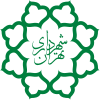
Back Tèhran ACE Тегеран ADY Teheran Afrikaans Teheran ALS ቴህራን Amharic Teherán AN Tehrān ANG طهران Arabic ܛܗܪܐܢ ARC طهران ARY
Tehran
تهران | |
|---|---|
|
Clockwise from top Azadi Tower; Tabiat Bridge and Alborz; National Garden; National Museum; City Theater; Golestan Palace and Milad Tower | |
 | |
Location in Iran and Asia | |
| Coordinates: 35°41′21″N 51°23′20″E / 35.68917°N 51.38889°E | |
| Country | Iran |
| Province | Tehran |
| County | Tehran Rey Shemiranat |
| District | Central |
| Government | |
| • Mayor | Alireza Zakani |
| • City Council Chairman | Mehdi Chamran |
| Area | |
| • Urban | 615 km2 (237 sq mi) |
| • Metro | 2,235 km2 (863 sq mi) |
| Elevation | 900 to 1,830 m (2,952 to 6,003 ft) |
| Population | |
| • Estimate (2018) | 9,400,000 |
| • Density | 11,800/km2 (31,000/sq mi) |
| • Urban | 9,039,000[3] |
| • Metro | 15,800,000[4] |
| • Population rank in Iran | 1st |
| Demonym | Tehrani (en) |
| Time zone | UTC+03:30 (IRST) |
| Area codes | +98 21 |
| Climate | BSk |
| Website | tehran.ir |
Tehran (/tɛəˈræn, -ˈrɑːn, ˌteɪ-/; Persian: تهران Tehrân [tehˈɾɒːn] ⓘ) is the capital and largest city of Iran, also serving as the capital of the Province, County and the Central District. With a population of around 9.4 million in the city, and 16.8 million in the metropolitan area, Tehran is the most populous city in Iran and Western Asia, the second-largest metropolitan area in the West Asia, and the 24th most populous metropolitan area in the world. Greater Tehran includes several municipalities, including "New Town of Andisheh", "Islam Shahr", "Shahreh Qods", "Shahryar", "Pakdasht", "Firooz Kooh" and "Shamiran".
Settlement in Tehran dates back over 6,000 years, with the name was first mentioned in historical accounts in an 11 th-century chronicle as a small village in the north of ancient Ray, a prominent Median city.[6] Ray was later absorbed into the metropolitan area of Greater Tehran. The city was first chosen as the capital of Iran by Agha Mohammad Khan of the Qajar Empire in 1786, because of its proximity to Iran's territories in the Caucasus, then separated from Iran in the Russo-Iranian Wars, to avoid the vying factions of the previously ruling Iranian dynasties. The capital has been moved several times throughout history, however, and Tehran became the nation's 32nd capital. Large-scale construction works began in the 1920s, and Tehran became a destination for mass migrations from all over Iran since the 20th century.[7]
Tehran is home to countless historical sites, including the royal complexes of Golestan, Sa'dabad, and Niavaran, where the last two dynasties of Iran were seated. Tehran's landmarks include the Azadi Tower, a memorial built under the reign of Mohammad Reza of the Pahlavi dynasty in 1971 to mark the 2,500th anniversary of the Persian Empire, the Milad Tower, the world's sixth-tallest self-supporting tower, completed in 2007, and the Tabiat Bridge, completed in 2014.[8]
Most of the population are Persian, with roughly 99% of them speaking the Persian language, alongside other ethnolinguistic groups in the city which became Persianized and assimilated.[9][10][11]
Tehran is served by Imam Khomeini International Airport, alongside the domestic Mehrabad Airport, a central railway station, Tehran Metro, a bus rapid transit system, trolleybuses, and a large network of highways.
According to the Global Destinations Cities Index in 2016, Tehran is among the top-10 fastest growing destinations.[12] In 2016, Tehran City Council declared October 6 the Tehran Day, celebrating the date when the city officially became the capital of Iran in 1786.[13]
- ^ "City of Tehran Statisticalyearbook" (PDF). Archived (PDF) from the original on 13 April 2021. Retrieved 13 April 2021.
- ^ Tehran, Environment & Geography Archived 2015-11-17 at the Wayback Machine. Tehran.ir.
- ^ "Population of Tehran". Archived from the original on 13 April 2021. Retrieved 13 April 2021.
- ^ "Major Agglomerations of the World - Population Statistics and Maps". citypopulation.de. 13 September 2018.
- ^ Urban population: Data for Tehran County. ~97.5% of county population live in Tehran city
Metro population: Estimate on base of census data, includes central part of Tehran province and Karaj County and Fardis from Alborz province - ^ "Tehran |". www.stonybrook.edu. Retrieved 17 May 2024.
- ^ "Tehran (Iran) : Introduction – Britannica Online Encyclopedia". Encyclopædia Britannica. Archived from the original on 30 March 2012. Retrieved 21 May 2012.
- ^ "Tabiat Pedestrian Bridge / Diba Tensile Architecture". ArchDaily. 17 November 2014. Archived from the original on 23 September 2015. Retrieved 12 October 2015.
- ^ Schuppe, Mareike. (2008). Coping with Growth in Tehran: Strategies of Development Regulation. GRIN Verlag. p. 13.
Besides Persian, there are Azari, Armenian, and Jewish communities in Tehran. The vast majority of Tehran's residents are Persian-speaking (98.3%).
- ^ Abbasi-Shavazi, Mohammad Jalal; McDonald, Peter; Hosseini-Chavoshi, Meimanat (30 September 2009). "Region of Residence". The Fertility Transition in Iran: Revolution and Reproduction. Springer. pp. 100–101.
- ^ Cite error: The named reference
tabnakwas invoked but never defined (see the help page). - ^ Erenhouse, Ryan. (22 September 2016). "Bangkok Takes Title in 2016 Mastercard Global Destinations Cities Index". MasterCard's newsroom. Archived from the original on 28 April 2017. Retrieved 12 June 2017.
- ^ "Citizens of Capital Mark Tehran Day on October 6". 6 October 2018. Archived from the original on 6 July 2019. Retrieved 7 October 2018.
© MMXXIII Rich X Search. We shall prevail. All rights reserved. Rich X Search









